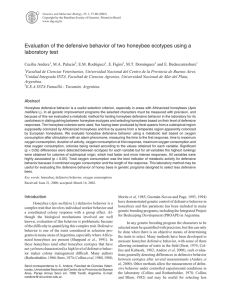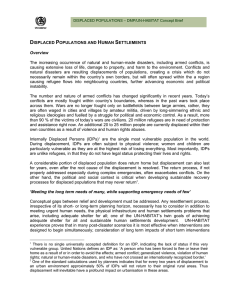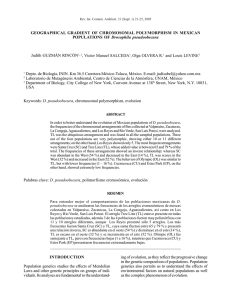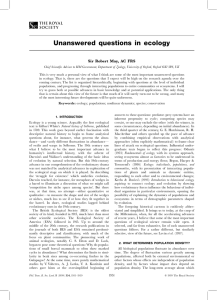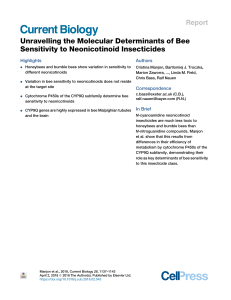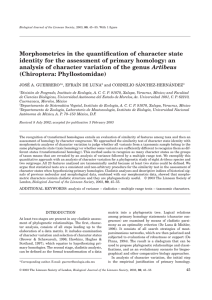Morphometric and Electrophoretic Variation in Different
Anuncio
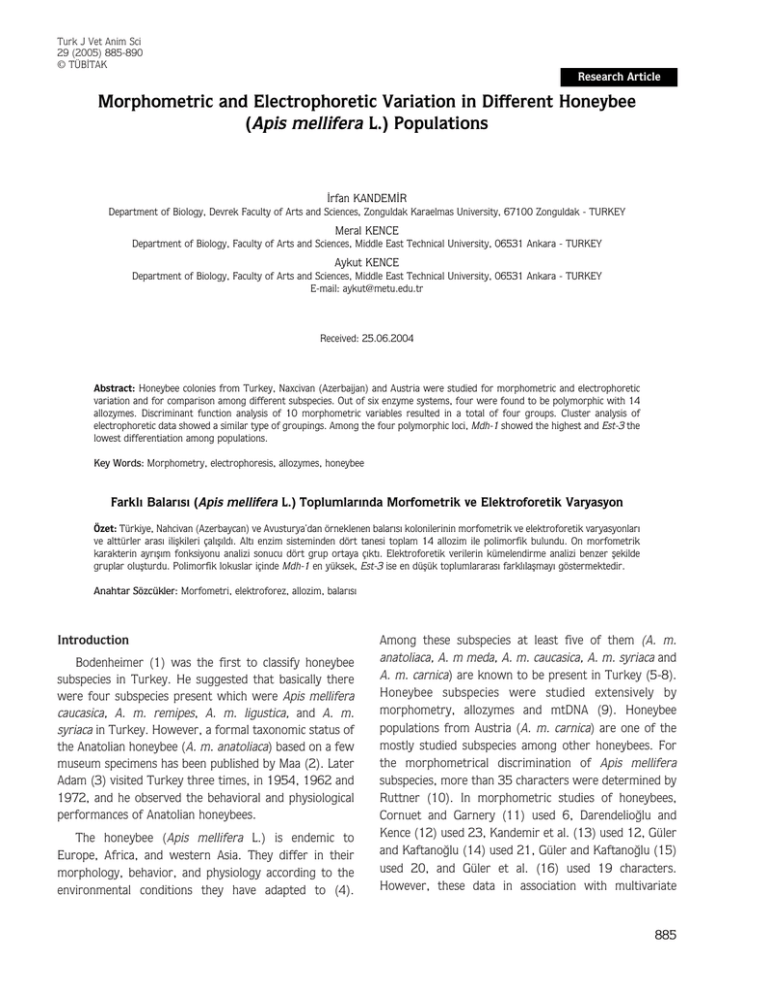
Turk J Vet Anim Sci 29 (2005) 885-890 © TÜB‹TAK Research Article Morphometric and Electrophoretic Variation in Different Honeybee (Apis mellifera L.) Populations ‹rfan KANDEM‹R Department of Biology, Devrek Faculty of Arts and Sciences, Zonguldak Karaelmas University, 67100 Zonguldak - TURKEY Meral KENCE Department of Biology, Faculty of Arts and Sciences, Middle East Technical University, 06531 Ankara - TURKEY Aykut KENCE Department of Biology, Faculty of Arts and Sciences, Middle East Technical University, 06531 Ankara - TURKEY E-mail: [email protected] Received: 25.06.2004 Abstract: Honeybee colonies from Turkey, Naxcivan (Azerbaijan) and Austria were studied for morphometric and electrophoretic variation and for comparison among different subspecies. Out of six enzyme systems, four were found to be polymorphic with 14 allozymes. Discriminant function analysis of 10 morphometric variables resulted in a total of four groups. Cluster analysis of electrophoretic data showed a similar type of groupings. Among the four polymorphic loci, Mdh-1 showed the highest and Est-3 the lowest differentiation among populations. Key Words: Morphometry, electrophoresis, allozymes, honeybee Farkl› Balar›s› (Apis mellifera L.) Toplumlar›nda Morfometrik ve Elektroforetik Varyasyon Özet: Türkiye, Nahcivan (Azerbaycan) ve Avusturya’dan örneklenen balar›s› kolonilerinin morfometrik ve elektroforetik varyasyonlar› ve alttürler aras› iliflkileri çal›fl›ld›. Alt› enzim sisteminden dört tanesi toplam 14 allozim ile polimorfik bulundu. On morfometrik karakterin ayr›fl›m fonksiyonu analizi sonucu dört grup ortaya ç›kt›. Elektroforetik verilerin kümelendirme analizi benzer flekilde gruplar oluflturdu. Polimorfik lokuslar içinde Mdh-1 en yüksek, Est-3 ise en düflük toplumlararas› farkl›laflmay› göstermektedir. Anahtar Sözcükler: Morfometri, elektroforez, allozim, balar›s› Introduction Bodenheimer (1) was the first to classify honeybee subspecies in Turkey. He suggested that basically there were four subspecies present which were Apis mellifera caucasica, A. m. remipes, A. m. ligustica, and A. m. syriaca in Turkey. However, a formal taxonomic status of the Anatolian honeybee (A. m. anatoliaca) based on a few museum specimens has been published by Maa (2). Later Adam (3) visited Turkey three times, in 1954, 1962 and 1972, and he observed the behavioral and physiological performances of Anatolian honeybees. The honeybee (Apis mellifera L.) is endemic to Europe, Africa, and western Asia. They differ in their morphology, behavior, and physiology according to the environmental conditions they have adapted to (4). Among these subspecies at least five of them (A. m. anatoliaca, A. m meda, A. m. caucasica, A. m. syriaca and A. m. carnica) are known to be present in Turkey (5-8). Honeybee subspecies were studied extensively by morphometry, allozymes and mtDNA (9). Honeybee populations from Austria (A. m. carnica) are one of the mostly studied subspecies among other honeybees. For the morphometrical discrimination of Apis mellifera subspecies, more than 35 characters were determined by Ruttner (10). In morphometric studies of honeybees, Cornuet and Garnery (11) used 6, Darendelio¤lu and Kence (12) used 23, Kandemir et al. (13) used 12, Güler and Kaftano¤lu (14) used 21, Güler and Kaftano¤lu (15) used 20, and Güler et al. (16) used 19 characters. However, these data in association with multivariate 885 Morphometric and Electrophoretic Variation in Different Honeybee (Apis mellifera L.) Populations statistical and electrophoretic analyses provided a good discrimination among populations of the subspecies. Although A. m. carnica was well studied there is no study corresponding to honeybee populations from Naxcivan with respect to morphometry and allozymes. Honeybee populations from Turkey, however, were studied extensively after 1995. Kandemir and Kence (5) and Asal et al. (17) reported the allozyme variation in central Anatolian honeybee populations. Further extensive morphometric and allozymic studies in Turkey (7) showed that Turkey is close to the origin of genetic diversity in honeybee evolution. Smith et al. (6) and Palmer et al. (8) reported the mtDNA variation present in Turkey and with respect to mtDNA, and that Turkish honeybees belonged to the Eastern Mediterranean C lineage. In this study, allozymic and morphometric variations in honeybee populations from Turkey were studied and compared with honeybee populations extending from west to east (Austria to Naxcivan-Azerbaijan) in order to see the changes in morphometric characters and allozyme frequencies and to assess subspecific relationships of populations distributed in this region. Materials and Methods Honeybee colonies were collected from eight populations in Turkey, one location from Naxcivan (Azerbaijan) and one location from Austria. A total of 135 colonies were sampled. Approximately 1000 honeybee workers were used in the analysis (all from stationary apiaries). For sampling details of morphometric and electrophoretic analysis see Kandemir et al. (7). The statistical analysis (discriminant function analysis) was performed with SPSS/PC, SYN-TAX and NTSYS program packages on only morphometric data. For allozyme study 6 enzyme systems known to be polymorphic in honeybees were selected: Pgm-1, Mdh-1, Hk, Est-3, Me, and Pgi. The electrophoresis was carried out on thorax homogenates on 12% horizontal starch gel. Enzyme activity was visualized using standard histochemical staining methods (5). For each locus allozyme frequency, average heterozygosities, population differentiation values (FST) and a phylogenetic relationships were computed by the BIOSYS-1 program. 886 Results In the present study, 10 morphometric variables were measured for morphometric analysis. Their original measurements and standard errors are given in Table 1. Morphometric analysis: Except for metatarsus length, all of the 9 morphometric variables were significantly different among the populations (P < 0.001). Figure 1 shows the results of discriminant function analysis. Four groups can be visualized: (i) Ankara colonies (Central Anatolia) formed a cluster, (ii) honeybee populations from the European part of Turkey (Kırklareli and Edirne) including the neighboring locality Bolu and Austrian colonies clustered together. (iii) The third group, however, consisted of honeybee populations from northeastern Turkey, and the fourth group (iv) consists of Naxcivan (Azerbaijan) populations. st nd The 1 axis explained 43%, the 2 axis 24.1% and rd the 3 axis 15.1% of the total variation. Thus 82.2% of the total variation could be explained by the first three canonical variates. Allozymes Of the six enzyme systems assayed with horizontal starch gel electrophoresis, four (Pgm-1, Mdh-1, Hk, and Est-3) were found to be polymorphic and two (Pgi and Me) exhibited invariant banding pattern. All isozymes were designated using relative mobilities with respect to the most common isozyme used as a standard (Mobility 100) (Table 2). The highest number of alleles was observed in Edirne. The maximum polymorphism was observed (33.3) in Edirne, Kars, Kırklareli, and Austria colonies. Kırklareli has the highest mean heterozygosity (0.140) among the 10 populations studied. Ankara, Austria, Naxcivan, Bolu, and I¤dır were in Hardy-Weinberg equilibrium for all enzyme systems. Edirne populations deviated from H-W equilibrium only in Mdh-1 enzyme system. Kırklareli, Artvin, and Kars populations, however, showed deviations in favor of Pgm-1 heterozygotes. Ardahan populations deviated for Pgm-1 and Hk enzyme systems. The highest differentiation among the populations was caused by the Mdh-1 enzyme system. The lowest differentiation, however, was due to Est-3. The homogeneity X2 test among populations showed highly significant (P < 0.001) heterogeneity due to the differences in allele frequencies. ‹. KANDEM‹R, M. KENCE, A. KENCE Table 1. Original values (mm) of 10 morphometrical characters (A, wing characters; B, leg characters) in honeybee populations from Turkey, Austria, and Naxcivan. A) Wing characters Populations # of N Cubital Cubital Wing C Wing D Wing Wing Cubital A B Value Value Length Width Index Hive Austria 4 29 0.564 ± 0.011 0.203 ± 0.006 0.776 ± 0.007 1.881 ± 0.008 8.807 ± 0.022 2.983 ± 0.017 2.783 ± 0.085 K›rklareli 27 233 0.531 ± 0.006 0.197 ± 0.004 0.978 ± 0.015 1.875 ± 0.005 8.859 ± 0.016 3.452 ± 0.058 2.718 ± 0.057 Edirne 19 93 0.530 ± 0.008 0.232 ± 0.004 0.828 ± 0.005 1.898 ± 0.012 8.784 ± 0.031 2.925 ± 0.015 2.293 ± 0.060 Bolu 20 167 0.522 ± 0.007 0.243 ± 0.006 0.857 ± 0.006 1.883 ± 0.010 8.822 ± 0.030 2.959 ± 0.015 2.171 ± 0.061 Ankara 4 28 0.473 ± 0.019 0.202 ± 0.004 0.767 ± 0.012 1.813 ± 0.004 8.467 ± 0.007 2.805 ± 0.010 2.348 ± 0.108 Ardahan 20 105 0.530 ± 0.005 0.245 ± 0.004 0.875 ± 0.003 1.887 ± 0.006 8.897 ± 0.016 2.966 ± 0.011 2.173 ± 0.048 Artvin 18 151 0.539 ± 0.004 0.252 ± 0.005 0.879 ± 0.004 1.891 ± 0.008 8.971 ± 0.027 2.956 ± 0.010 2.157 ± 0.050 I¤d›r 5 26 0.529 ± 0.008 0.229 ± 0.015 0.919 ± 0.041 1.879 ± 0.019 8.858 ± 0.051 2.881 ± 0.003 2.352 ± 0.199 Kars 9 63 0.530 ± 0.009 0.271 ± 0.002 0.847 ± 0.007 1.868 ± 0.007 8.765 ± 0.019 2.871 ± 0.010 1.953 ± 0.044 Naxcivan 15 85 0.559 ± 0.004 0.229 ± 0.006 0.857 ± 0.004 1.829 ± 0.013 8.593 ± 0.029 2.888 ± 0.012 2.469 ± 0.071 Populations # of N Metatarsus Metatarsus Femur Tibia Hive A Length Width Length Length 2.435 ± 0.013 B) Leg characters Austria 4 29 1.954 ± 0.014 1.114 ± 0.001 2.940 ± 0.017 K›rklareli 27 233 2.018 ± 0.014 1.282 ± 0.014 3.011 ± 0.024 2.811 ± 0.038 Edirne 19 93 1.965 ± 0.016 1.165 ± 0.007 2.803 ± 0.023 2.395 ± 0.020 Bolu 20 167 1.991 ± 0.028 1.157 ± 0.007 2.843 ± 0.026 2.447 ± 0.036 Ankara 4 28 1.957 ± 0.021 1.150 ± 0.006 2.971 ± 0.025 2.442 ± 0.011 Ardahan 20 105 1.986 ± 0.012 1.192 ± 0.005 3.110 ± 0.018 2.456 ± 0.010 Artvin 18 151 2.023 ± 0.065 1.184 ± 0.005 3.049 ± 0.022 2.456 ± 0.013 I¤d›r 5 26 2.004 ± 0.047 1.157 ± 0.044 3.075 ± 0.019 1.963 ± 0.034 Kars 9 63 1.936 ± 0.015 1.138 ± 0.013 3.054 ± 0.026 2.443 ± 0.010 Naxcivan 15 85 1.907 ± 0.013 1.128 ± 0.009 2.987 ± 0.011 2.317 ± 0.017 Table 2. Gene frequencies of four polymorphic enzymes in honeybee populations from Turkey, Naxcivan (Azerbaijan), and Austria. Populations # of N Hive PGM PGM PGM HK HK HK HK MDH MDH MDH MDH EST EST EST 45 75 100 77 87 100 110 65 87 100 116 70 100 130 0.069 Austria 4 29 - 1.000 - - - 1.000 - 0.879 - 0.121 - - 0.931 K›rklareli 27 233 - 0.758 0.242 - - 1.000 - 0.367 - 0.633 - 0.004 0.996 - Edirne 19 93 0.027 0.925 0.048 - 0.016 0.984 - 0.231 - 0.758 0.011 0.005 0.984 0.011 Bolu 20 167 - 0.760 0.240 0.006 - 0.994 - 0.018 - 0.982 - 0.012 0.988 - Ankara 4 28 - 1.000 - - - 1.000 - - - 1.000 - - 1.000 - Ardahan 20 105 - 0.800 0.200 0.033 0.005 0.952 - 0.005 - 0.995 - - 1.000 - Artvin 18 151 - 0.752 0.248 0.007 - 0.993 - 0.003 - 0.997 - - 1.000 - I¤d›r 5 26 - 0.750 0.250 - - 1.000 - - - 1.000 - - 1.000 - Kars 9 63 - 0.730 0.270 - - 0.984 0.016 - - 0.889 0.111 - 1.000 - Naxcivan 15 85 - 0.888 0.112 - - 0.982 0.018 - 0.012 0.988 - - 1.000 - 887 Morphometric and Electrophoretic Variation in Different Honeybee (Apis mellifera L.) Populations 3 Artvin I¤d›r Ardahan Bolu 0 Kars K›rklareli Edirne Naxcivan Austria Ankara -5 0 5 Figure 1. Two dimensional clustering in Discriminant Function Analysis of 10 populations from Turkey, Naxcivan (Azerbaijan), and Austria based on morphometric data. ED‹RNE NAXCIVAN KARS I⁄DIR ARTV‹N BOLU ARDAHAN ANKARA KIRKLAREL‹ AUSTRIA 0.000 0.020 0.040 0.060 0.080 0.100 0.120 Figure 2. Distance-Wagner clustering of 10 honeybee populations based on Prevosti Distance calculated from allozyme data. Figure 2 shows the phylogenetic relationships among populations as revealed by the distance-Wagner analysis based on the Prevosti genetic distance calculated from allozyme data. More or less similar types of groupings were observed (see Figure 1). Austrian colonies and Kırklareli colonies formed the first cluster. In the second cluster, Anatolian honeybees (Ankara, Bolu, Artvin, Kars, Ardahan, and I¤dır) and Naxcivan formed a coherent group, whereas Edirne was on the second branch of this cluster. 888 Discussion A wide range of genetic and electrophoretic variation occurs in a geography extending from Austria to Naxcivan (Azerbaijan). A. m. carnica, A. m. anatoliaca, and A. m. caucasica subspecies could be differentiated morphometrically in this study as would be expected according to Ruttner (4). Honeybee populations from Naxcivan (Azerbaijan) were close to the A. m. caucasica ‹. KANDEM‹R, M. KENCE, A. KENCE cluster (Artvin, Ardahan, Kars, and I¤dır) but did not coincide with it exactly. The colonies from Naxcivan are probably A. m. meda, which were classified as remipes by Bodenheimer (1). Honeybees from Anatolia (Ankara, Beypazarı) were found to be distinct from other two clusters and they represent A. m. anatoliaca. Thrace populations were thought to be A. m. carnica and are clustered with Austrian colonies, which were known to be A. m. carnica (Figure 1). On the one hand, cubital index, a diagnostic morphometric ratio for honeybee subspecies, also showed similarity between honeybee populations from Kırklareli (2.718) and Austria colonies (2.783). On the other hand, Edirne populations exhibited quite a low cubital index (2.293). Migratory beekeepers from Anatolia frequented Edirne quite often, whereas honeybee populations of Kırklareli are isolated from other parts of Turkey in that few migratory beekeepers visited this region. This may explain the differences between Kırklareli and Edirne populations. The pattern we observed in the discriminant function analysis based on morphometric data is also supported by the clustering obtained from distance-Wagner analysis (Figure 2) based on allozyme data. High frequency of Mdh-65 allele has high loadings on the separation of Kırklareli and Austria colonies from the rest of the groups. Although Edirne populations joined with the other group, they are separated enough from those groups as was the case for Ankara populations. Bolu populations joined closely within populations from northeast Turkey (Artvin, Ardahan, Kars); this may be because the Bolu ecotype is under the similar climatic influences (Black Sea) as the Artvin, Ardahan, and Kars honeybee populations. The grouping from discriminant function analysis of morphometric data and the clustering obtained from the distance-Wagner analysis based on Prevosti distance from allozyme data agreed well with one another. In European honeybee populations, Mdh-65 frequencies ranged between 0.879 and 0.231, whereas populations from the Asian side have the highest frequency in Bolu (0.018). Here again the Edirne population has the lowest Mdh-65 frequency (0.231) on the European side, which indicates the effect of gene flow from Anatolia due to migratory beekeepers. Nevertheless, the European and Asian populations can easily be distinguished on the basis of Mdh frequencies. The highest FST values (0.3157) were observed for this enzyme system. This high FST is largely due to differences between the European and Asian populations used in this study. Similarly Hk locus is fixed for Hk-100 in Kırklareli and Austria honeybees, whereas Hk locus in Edirne exhibits small amount of genetic variation evidencing introgression from Anatolia. Hk locus in all of the honeybee populations on the Asian side showed polymorphism. As one goes southward this polymorphism increases (7). However, the FST value observed for Hk is the lowest (0.0144) among the four polymorphic loci in this study, indicating the lowest differentiation between the populations. Est-3 enzyme systems are variable in Anatolia, Thrace, and Austria but fixed for Est-100 in northeast Turkey and Naxcivan where A. m. caucasica is distributed. No electrophoretic variability was detected in Ankara samples probably because of the small sample size. However, in a previous detailed study in Central Anatolia (Ankara) by Kandemir and Kence (5), electrophoretic variability in these four enzyme systems was reported. European and Anatolian honeybee populations were well separated in the discriminant function analysis using morphometric variables and distance-Wagner clustering based on allozymes. According to mtDNA data (18) Apis mellifera populations in the European and Asian parts of Anatolia could not be well distinguished. Instead the data showed that all European and Anatolian populations belonged to C lineage, as Smith et al. (6) reported earlier. mtDNA results add the new finding that there is another lineage in southern Anatolia (Hatay) that can be classified into A (19) or O lineage (8,20) based on restriction analysis and sequencing of mtDNA, but also showed that there are not unique patterns related to the European part of Turkey. On the other hand, Palmer et al. (8) stated that Tekirda¤ populations have Eastern Type 2 restriction pattern, which has PoQ sequence on their COI-COII intergenic region, but this unique pattern is only found in Hatay colonies in southern Turkey. Based on this restriction pattern, Palmer et al. (8) concluded that Thrace populations were not different from Anatolian honeybee populations. It is clearly shown in the present work that both electrophoretical and morphometrical data separated both populations well but not mtDNA. There seems to be a conflict with our results and those in Palmer et al. (8) or this could be attributed to migratory beekeeping or gene flow between two populations (Tekirda¤ and Hatay). 889 Morphometric and Electrophoretic Variation in Different Honeybee (Apis mellifera L.) Populations Each character and combinations of characters show different distributions. On this basis it is difficult to place boundaries between the populations of honeybees separating subspecies. Bodenheimer (1), studying honeybee races in Turkey, reached the conclusion that honeybees show local variations within subspecies. Louveaux (21) also suggested the presence of ecotypes in honeybees. The presence of great genetic diversity in Anatolian honeybee populations as we have observed suggests that Anatolia may be close to the center of origin of honeybees (4). References 13. Kandemir, ‹., Kandemir, G., Kence, M., ‹nci, A., Kence, A.: Morphometrical and electrophoretical discrimination of honeybees from different regions of Turkey. XXXIVth International Apicultural Congress in Apimondia, 14-19 August 1995, Lausanne, Switzerland. 14. Güler, A., Kaftano¤lu, O.: Türkiye’deki önemli balarısı (Apis mellifera L.) ırk ve ekotiplerinin morfolojik özellikleri-I. Turk. J. Vet. Anim. Sci., 1999; 23: Suppl. 3: 565-570. 15. Güler, A., Kaftano¤lu, O.: Türkiye’deki önemli balarısı (Apis mellifera L.) ırk ve ekotiplerinin morfolojik özellikleri-II. Turk. J. Vet. Anim. Sci., 1999; 23: Suppl. 3: 571-575. 16. Güler, A., Akyol, E., Gökçe, M., Kaftano¤lu, O.: Artvin ve Ardahan yöresi balarıları (Apis mellifera L.)’nın bazı morfolojik özellikler yönünden iliflkilerinin belirlenmesi. Turk. J. Vet. Anim. Sci., 2002; 26: 595-603. Kandemir ‹., Kence, M., Kence, A.: Genetic and morphometric variation in honeybee (Apis mellifera L.) populations in Turkey. Apidologie, 2000; 31: 343-356. 17. Asal, S., Kocabafl, S., Elmacı, C., Yıldız, M.A.: Enzyme polymorphism in honey bee (Apis mellifera L.) from Anatolia. Turk. J. Zool., 1995; 19: 153-156. 8. Palmer, M.R., Smith, D.R., Kaftano¤lu, O.: Turkish honeybees: Genetic variation and evidence for a fourth lineage of Apis mellifera mtDNA. J. Hered., 2000; 91: 42-46. 18. 9. Sheppard, W.S., Smith, D.R.: Identification of African-derived bees in the Americas: A survey of methods. Ann. Entomol. Soc. Am., 2000; 93: 159-176. Kence, M., Kence, A., Kandemir, ‹.: Türkiye’de balarısı ırklarının (Apis mellifera L.) karakterizasyonu ve korunması. TÜB‹TAK Veterinerlik ve Hayvancılık Arafltırma Grubu, Proje No VHAG1077, Kesin Raporu, fiubat, 1998. 19. Arias, M.C., Sheppard, W.S.: Molecular phylogenetics of honeybee subspecies (Apis mellifera L.) inferred from mitochondrial DNA sequence. Mol. Phyl. Evol., 1996; 5: 557–566. 1. Bodenheimer, F.S.: Studies on the Honeybee and Beekeeping in Turkey. Merkez Ziraat Mücadele Enstitüsü, Ankara, 1942. 2. Maa, T.: An inquiry into the systematics of the tribus Apidini or honeybees (Hym.). Treubia, 1953; 21: 525-640. 3. Adam, B.: In Search of Best Strains of Honeybees. 2nd Edition, Northern Bee Books, UK. 206p, 1983. 4. Ruttner, F.: Naturgeschichte der Honigbienen. München: Ehrenwirth, 357p, 1992. 5. Kandemir, I., Kence, A.: Allozyme variation in a central Anatolian honeybee (Apis mellifera L.) population. Apidologie, 1995; 26: 503-510. 6. Smith, D.R., Slaymaker, A., Palmer, M., Kaftano¤lu, O.: Turkish honeybees belong to the east Mediterranean lineage. Apidologie, 1997; 28: 269-274. 7. 10. Ruttner, F.: Biogeography and Taxonomy of Honeybees. Springer-Verlag, Berlin, Heildelberg, 1988. 20. 11. Cornuet, J.M., Garnery, L.: Genetic diversity in Apis mellifera In: Smith, D.R. Ed. Diversity in the genus Apis. Westview Press, Boulder, CO, 1991. Frank, P., Garnery, L., Solignac, M., Cornuet, J.M.: Molecular confirmation of a fourth lineage in honeybees from the Near East. Apidologie, 2000; 31: 167-180. 21. 12. Darendelio¤lu, Y., Kence, A.: Morphometric study on population structure on honeybee, Apis mellifera L. (Hymenoptera: Apidae). Türkiye 2. Entomoloji Kongresi Bildirileri, 1992; 387-396. Louveaux, J.: Ecotypes in honeybees. International Apicultural Congress (Apimondia) 1969; 22: 499-501. 890
